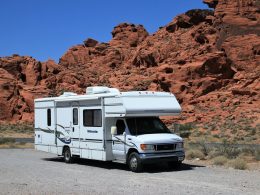RVers and non-RV drivers can have a complicated relationship. Car drivers can become annoyed when motorhomes are driving at a lower speed limit, and RVers get frustrated at their impatience. The association is a two-way street, but there are some things that RVers simply hate about non-RV drivers.
Let’s see what’s separating the two parties.
Driving an RV Comes with Its Challenges
RVs aren’t your typical vehicle. They’re not only massive, but they’re also cumbersome. While the general process of driving an RV is similar to a passenger vehicle, there’s a lot more to consider. Driving an RV requires skills that take time to develop.
Whether large or small, an RV needs a much wider turning radius. Some turns even require the opposing lane to avoid curbs, street signs, and other obstacles. Non-RV drivers may not understand the necessity for space and grow frustrated.
Another challenge for driving an RV is not only stopping but also starting. The more your RV weighs, the more effort it requires for stopping and accelerating. This can make city driving painful and frustrating for RVers. Interstates are typically an RV’s best friend because you can get on them and cruise with limited interruption.
The actual process of driving an RV isn’t the only challenge, though. Trying to find a parking spot can be nearly impossible in some instances. When pulling an RV into a parking lot, you need a plan for how you’ll exit the lot as well. You have to consider any obstacles or traffic patterns that could be difficult to navigate in an RV.

Hot Tip: Have you ever wondered what type of RV is the easiest to drive? We have the answer.
Things Non-RV Drivers Do That Drive RVers Crazy
Some RV driving challenges are out of an RVer’s control. They rely on certain driving practices and etiquette from non-RV drivers as well.
So, when car drivers don’t follow the rules and etiquette of the road, it can be annoying or even dangerous to RVers. Here are some things that drive this crowd crazy.
Not Signaling
Communication can help prevent many difficult or frustrating situations, including while driving. Using turn signals is a way for drivers to communicate with the drivers around them that they’re planning to change lanes or go in a different direction. While drivers may have learned turn signal etiquette in Driver’s Ed 101, many drivers often overlook or ignore it.
When non-RV drivers don’t signal, it gives little to no notice of the driver’s intentions. RVers are looking ahead and constantly making mental calculations when it comes to stopping distances or which lane they need to be in for their exit. A vehicle changing lanes unexpectedly can mess with an RVer’s calculations and cause an overreaction or even an accident.

Cutting Off an RV
Many passenger vehicles can slow down or stop quickly; the same is not true for RVs. By cutting off an RV, non-RV drivers put themselves and RVers in a dangerous situation. If the non-RV driver needs to brake for any reason, there’s a good chance the RV can’t slow down in time.
RVs are typically beefier than a typical passenger vehicle, which would stand very little chance against an RV in a collision. In accidents like these, RVs have thousands of pounds of force smashing into the rear of the vehicle in front of them. This is why drivers should always wait for ample space between vehicles when passing before getting in front of them.
Pulling out in Front of an RV
Similar to cutting off an RV, pulling out in front of an RVer will drive them crazy, too. RVs cannot slow down or adjust their path as quickly or easily as smaller vehicles. This means an RVer might not be able to avoid an accident, especially when there’s limited space.
While it can be frustrating to get behind a slow-moving RV, getting into an accident by pulling in front of them will not get you to your destination faster.
Following Too Closely
Safety is always the top priority when driving a massive vehicle like an RV. As a result, the best RVers will never exceed the posted speed limit or the speed rating on their tires. Many RVers, regardless of whether their tires have a higher rating, see 65 mph as the sweet spot for safety.
This can be incredibly frustrating to other drivers who may have no problem driving 10 or 15 mph over the speed limit. Following an RV closely won’t change their minds. They’re not likely to sacrifice safety because you’re in a hurry.
When vehicles follow an RV too closely, it can distract the driver. They’ll likely spend more time looking behind them to keep an eye on the offending vehicle and not enough time on the road in front of them.

Parking Right Next to an RV
RVers often need to make stops to pick up supplies and other items along their route. While they try to avoid parking in parking lots, it’s not always possible. Because RVs can’t typically fit in a standard parking spot, RVers will often park towards the back or in an out of the way spot of a parking lot.
However, some non-RV drivers forget that RVs and other large vehicles require generous room to maneuver. The offending party could prevent the RV from leaving by parking too close. This can be incredibly frustrating, especially in large parking lots with plenty of available parking for standard-sized vehicles.
Give Non-RVs the Benefit of the Doubt
If you’re an RVer, cut the non-RV drivers some slack. They don’t know what they don’t know, especially if they’ve never driven an RV or towed a trailer. It’s easy for them to overlook the need for space or to be impatient and in a hurry.
While it may feel like they’re intentionally trying to drive you crazy, they’re likely not. Give them the benefit of the doubt and know that no one is a perfect driver, RVers included.

Be a Positive RV Representative
One of the worst things RVers do is to be a negative representative to the community. The golden rule of treating others how you wish to be treated can also apply to driving.
Make sure you’re using your turn signal, keeping your distance, and being flexible with letting others merge and change lanes. Be the driver that you want other drivers to be on the road.
Ultimately, RV and non-RV drivers share the roads. They all have a destination, and it takes some teamwork for everyone to get there without incident. Both parties can drive each other crazy and cause a stressful situation. Being aware and respectful of each other while on the road can make a big difference.
Let’s keep the conversation going. What do non-RV drivers do that drives you crazy while driving an RV?
If You Want the Latest Travel News, Join Our Mailing List
Don’t rely on biased RV industry news sources to keep you informed. Stick with Nomadic News. We publish articles and breaking stories that matter to you every weekday.










